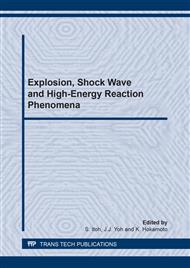p.1
p.11
p.21
p.35
p.41
p.47
p.53
p.59
A Framework for Analyzing the Microstructure Level Thermomechanical Response Polymer Bonded Explosives
Abstract:
A framework for quantifying the thermomechanical response of polymer bonded explosives (PBX) at the microstructural level is developed using a cohesive finite element method (CFEM). This framework allows the contributions of individual constituents, fracture and frictional contact along failed crack surfaces to heating to be analyzed and tracked. Digitized micrographs of actual PBX materials and idealized microstructures with various distributions of grain sizes are used in the analysis. The analysis concerns impact loading of HMX/Estane with strain rates on the order of 104 – 105 s-1. Issues studied include large deformation, thermomechanical coupling, failure in the forms of microcracks in both bulk constituents and along grain/matrix interfaces, and frictional heating. The Estane matrix is described by a thermo-elasto-viscoelastic constitutive formulation, accounting for temperature dependence, strain rate sensitivity and strain hardening. The HMX crystals are assumed to be elastic under the conditions analyzed. Energy localization leading to formation of local hot spots as potential ignition sites is primarily due to the viscoelastic dissipation in the matrix in early stages of deformation and frictional heating along crack surfaces in later stages of deformation. Microstructure-response relations that can be used in the design of soft energetic composites are established.
Info:
Periodical:
Pages:
21-33
Citation:
Online since:
January 2011
Authors:
Keywords:
Price:
Сopyright:
© 2011 Trans Tech Publications Ltd. All Rights Reserved
Share:
Citation:


